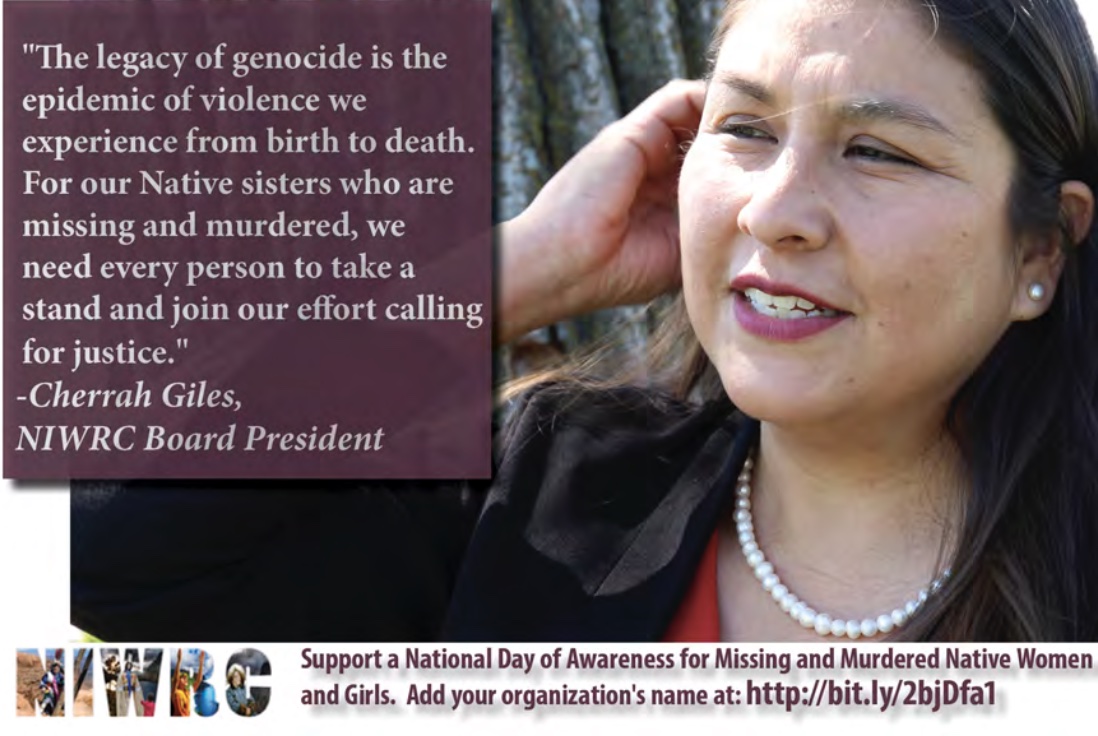Why a National Day of Awareness?

In 2005, the national movement for the safety of Native women led the struggle to include in the Violence Against Women Act a separate title for Native women called Safety for Indian Women. One of the findings that justified creation of the title was that during the period of 1979 through 1992, homicide was the third leading cause of death of Indian females aged 15 to 34, and 75 percent were killed by family members or acquaintances. Since that time, the U.S. Department of Justice has found that in some tribal communities, American Indian women face murder rates that are more than 10 times the national average.
“At a recent conference someone asked why is the rate so high? Is it a serial murderer? The disappearance and murder rate of Native women is not new. It began with the colonization of our nations,” said Terri Henry, Co-Chair, NCAI Task Force. “It is the result of the public perception that nothing will be done when a Native women disappears or is murdered. And yes, it is the result of the United States removing the authority of Indian tribes to protect women.”
The disappearance and murder of Native women is part of a spectrum of violence experienced from birth to death. The Department of Justice reports the rate of violent victimization among American Indian women is more than double that among all women. The disappearances and murders are the end result of this spectrum of violence.
“In Alaska, we are constantly responding to calls from mothers and the families of women who are missing,” said Tami Jerue, Director, Alaska Native Women’s Resource Center. “These fears are well founded in that Alaska Natives are murdered at a higher rate than other people in Alaska.” The Department of Justice reports American Indians in Alaska made up about 16% of the state’s total resident population and 28% of the murder victims. About 1 in 4 of the murder victims in Alaska from 1976 to 1999 were American Indians. (USDOJ, 2004, p. 13)
Murder of American Indians
The following statistics from American Indians and Crime (USDOJ, 2004) provide important information regarding murder of American Indians in the United States.
- In five states, Alaska (28%), North Carolina (2%), Washington (4%), Minnesota (7%), and Oregon (3%), the proportion of murder victims who were American Indian exceeded their proportion of each state’s resident population. (2004, p.14)
- About 1 in 4 of the murder victims in Alaska from 1976 to 1999 were American Indians. Alaska accounted for about 10% of all murdered American Indians and had 4% of the nation’s American Indian population. American Indians in Alaska made up about 16% of the state’s total resident population and 28% of the murder victims. (2004, p. 13)
- During 1976 to 1999 in most murder cases involving a white or black victim, the offender was the same race as the victim. For example, 86% of white murder victims and 94% of black murder victims were murdered by an offender of their respective race. By comparison, American Indians (58%) were less likely to be murdered by an offender of their own race. In about 32% of the cases, American Indians were murdered by a white offender; 10%, by a black; and in 1%, by an Asian. (2004, p. 14)





